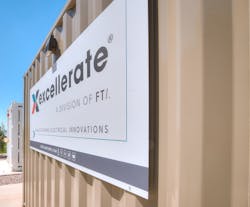Of course, that’s never really the case.
Constraints exist even with a greenfield site build—money supply is not endless; federal, state and local regulators carve out a variety of limitations; and manufacturers’ own production processes add restrictions. Moreover, nothing is ever perfect.
Still, building a new manufacturing plant gives companies and their people a chance to dream big and get that much closer to their ideal site. With that in mind, IndustryWeek set out to discover what’s on the wish lists of manufacturers raising new plants across the United States and how their journeys are going. What follows are the stories of three such manufacturers.
LEAN, GREEN SOLAR IN TEXAS
Company: GAF Energy
Location: Georgetown, Texas
Product: Solar power generating roof shingles
Size: 450,000 square feet
(Caption for photo at top: GAF Energy will build solar shingles for residential roofing at its Texas factory, scheduled to begin operations later this year. Photo courtesy: GAF Energy)
GAF Energy is at an exciting stage in its development. The San Jose, California-based solar roofing company launched in 2019, and last year it introduced Timberline Solar, a solar roofing system that integrates solar technology into traditional residential roofing processes. It features the first solar shingle that can be nailed onto a roof, according to the company. As part of well-established Standard Industries Inc., GAF Energy may be young, but it has lots of roofing expertise close at hand.
See Also: Building at the Speed of Now
To date, GAF Energy has been producing its Timberline Solar product in San Jose where it has a combined headquarters, research and development and a pilot manufacturing site. “Pilot” may be a bit of a misnomer in that GAF Energy is manufacturing product for sale at the 112,000-square-foot site, but it is a pilot in that the company has been using the facility to develop and refine its manufacturing processes for what is a brand-new product.
Simultaneous Development of Product and Process
“We were kind of simultaneously developing the product in the R&D labs, doing the material science on the materials … and while we were doing that, the manufacturing team was working on process development,” explains Ralph Robinett, GAF Energy senior vice president. “We were also designing the automation, leveraging some standard equipment as much as we could and then putting our unique processes on top of it.”
What the company can’t do in San Jose is scale production both to accommodate growing demand and reap the efficiencies and productivity that accompany economies of scale.
Soon, those challenges won’t be an issue. In August 2022, the manufacturer broke ground on a 450,000-square-foot manufacturing plant in Georgetown, Texas, located about 30 miles north of Austin. The new facility, which is expected to begin operations toward the end of this year, will in- crease capacity by 500%, according to GAF Energy. “When that building is done and we’re ramped, we’re confident that it will be the largest solar roofing manufacturing facility in the world,” says Robinett.
An Emphasis on Flow
The new site’s design emphasizes flow. The pilot factory in San Jose (not a greenfield build) is essentially a square and, therefore, not ideal to accommodate a Timberline Solar production footprint that includes a “fairly long” production line, Robinett explains.
In Georgetown, “We’re able to take a building that is much longer and generate proper U cells. And everything in San Jose was a ‘one of’ and (in Georgetown) we’ve been able to add redundancy. So instead of one line with a single point of failure, we now have multiple lines. It’s going to drive so much better OEE, so much better efficiency, by being able to move product between the lines, but we’ve been able to orient them in a very logical fashion,” he explains.
Lean thinking overlays GAF Energy’s manufacturing plans. It’s peppered in Robinett’s language, whether he is talking about the rapid cycles of learning in lean product development, or the single- piece-flow, minimizing travel or visual management aspects of lean manufacturing.
“First and foremost, of course, is the respect for the people, respect for the process,” he adds.
And speaking of visual management, George- town’s shop-floor design provides ample evidence of its use. Everyone who supports manufacturing at the new GAF Energy factory—production super- visor, maintenance technician, process engineer— will work from the equivalent of a fishbowl on the shop floor. The glass-walled room provides line of sight to the people and processes, and its location should speed response when difficulties arise on the production floor.
“We have a very open concept,” Robinett says.
The Georgetown production-floor layout is the result of many voices and more than a dozen drafts. Employing a brainstorming exercise called 7 Ways, GAF Energy captured ideas from employees representing maintenance, process engineering, shop-floor operations and other leaders. They were tasked with sketching out their ideas for the ideal layout, given the cost and capacity goals for the site. The San Jose plant started assembling Timberline Solar only last year, so even as employees there continue to develop best practices in production, they are sharing those learnings in the new site design.
Ultimately, the focus is the user experience, Robinett says.
Not Just 'We Know Best'
“It wasn’t just, ‘Okay, we have a team that builds factories so we know better,’” he says. “It’s ‘We learn everything (we) can from the people who actually have to operate, who have been learning and struggling with … either the mistakes we made or things we didn’t know or the changes that we made over the years.’”
The overall employee experience also includes the environment outside the plant. The city of Georgetown appealed to the solar manufacturer in part because the city-owned electrical utility supports renewable energies. For employees, the site is expansive. The company preserved groves of oaks trees and installed walking trails around a small lake on the approximately 50 acres of land on which the factory sits.
The location provides a short commute for many potential workers and for those coming from Austin, a reverse commute. The new site, Robinett says, “has easy access off the highway but also a very private feel to the campus. That’s something that was really attractive.”
“It’s so important to attract and retain talent, and it’s not just about the job, it’s the environment that you work in,” he says.
Now for a glimpse into two greenfield sites going up in Wisconsin and Colorado.
CLEAN ENERGY TECHNOLOGY IN WISCONSIN
Company: Excellerate (a division of Faith Technologies Inc.)
Location: Little Chute, Wisconsin
Product: Off-site-built electrical components
Size: 385,000 square feet
Even as GAF Energy expands into Texas, Excellerate is adding to its footprint with a 385,000-square-foot manufacturing plant on the rise in Little Chute, Wisconsin. The company, a division of Faith Technologies Inc., broke ground on the new facility in November 2022.
Excellerate occupies an interesting space in manufacturing. It produces and tests manufactured electrical components and assemblies that might otherwise largely be put together in the field. As Pat McGettigan, executive vice president, describes it, Excellerate is “industrializing construction work by taking labor offsite and building components in our controlled manufacturing facilities.” He cites increased productivity as a primary benefit.
Excellerate designed the new site to accommodate demand growth of its current products and to do so more efficiently. The company, however, also is anticipating significant demand growth for renewable energy products, including microgrids, and is growing its capacity to build those products for EnTech Solutions, a sister division focused on energy. It should come as no surprise, therefore, that smart manufacturing—or perhaps smart energy— is a significant focus of Excellerate’s new plant.
McGettigan outlines three examples of how it’s being incorporated:
- Smart breakers: “We monitor the power, we can track the power and we can set it up to be optimized to make sure we’re being as efficient as possible with energy us- age,” the executive vice president explains.
- Net zero: Excellerate is equipping the Little Chute facility to achieve net-zero status, although not immediately. “Our goal is to offset and ulti- mately to completely be able to come off the grid and run that whole fa- cility with renewable energy. Part of that may be wind, part of that may be solar or that may be from an alternative renewable energy source,” McGettigan says. “The electrical equipment we’re going to have inside that facility has to be able to adapt to that, so we did have to do a lot of thinking … on the front end to make sure we could do that.”
- Smart data: Where to innovate and where to automate requires having a good grasp of metrics. Getting a better handle of that data at the new site is part of the plan, McGettigan says. “How are we producing the products? How efficient is our manufacturing? We want to be able to capture as much data as possible with everything that we’re doing in that facility to drive innovation, also to drive productivity.”
Excellerate is taking a page from its own “industrializing construction” philosophy to accelerate the timeline at its Little Chute site. For example, two electrical rooms for the new plant will be built offsite and brought in, and to the degree possible, the electrical work will be completed offsite as subassemblies and then delivered to the site.
Similar to GAF Energy’s new manufacturing site, Excellerate’s new plant is scheduled for completion in the fall of 2023.
THERAPEUTICS IN COLORADO
Company: Agilent Technologies Inc.
Location: Frederick, Colorado
Product: Therapeutic oligonucleotides (oligos)
Size: 198,000 square feet
Our third example comes from Frederick, Colorado, where in February, Agilent Technologies Inc. broke ground on a $725 million, 198,000-square- foot expansion at the life sciences company’s campus in Frederick, Colorado. The expansion will double Agilent’s capacity to produce therapeutic nucleic acids, also called therapeutic oligonucleotides or oligos, used for drugs targeting cancer, cardiovascular disease and other ailments. Agi- lent says customer shipments from the expansion should begin in 2026.
Frederick has been a hotbed of activity for Agilent in recent years. In 2016 the company announced a 135,000-square-foot production facility in Frederick that opened in 2019. Just a year later the manufacturer announced a 25,000-square-foot expansion to house an additional production line. That additional production line is expected to go live this year.
Agilent’s latest expansion will add another two production lines as the projected market for oligos continues to grow. The new build will share some utilities with an existing plant and a warehouse will connect the two, but in all other ways it is a greenfield site.
“We started with a blank sheet of paper and voice of the customer, [also] taking what we had built in 2016 on that same site and trying to improve and make it the best we possibly could,” says Mary Beth Gibson, vice president of facilities and engineering for Agilent’s Nucleic Acid Solutions Division of the Diagnostics and Genomics Group.
Of course, Agilent Technologies operates in a highly regulated industry, so that blank sheet of paper likely isn’t quite so blank. Gibson says restrictions aren’t a bad thing. Building a new facility involves a lot of people and many different entities, “so the constraints almost help us corral the ideas.” The vice president says it’s also important that Agilent be “forward looking,” to make its best efforts to predict how those regulations will evolve over time so that what is built remains compliant through the lifecycle of products being manufactured.
“It does give me a little bit of juice to be able to build something I think will stand the test of time,” she says.
Like GAF Energy and Excellerate, flexibility and flow are important considerations in Agilent’s new build, says Gibson. And lessons learned from the existing facility and production lines will be incorporated into this latest venture, as will feedback from employees.
Gibson offered a bit of advice for anyone contemplating a new build or substantial addition, and it boils down to:
- Think before you leap. Take the time, she says, to consider what you want, with the end in mind.
- Perform voice of the customer surveys. Find out what your clients want and what your operators want.
- Don’t rush into detailed designs without perform- ing feasibility and conceptual work up front.
- Don’t let time constraints squeeze these important considerations out of the process.
She suggests it’s okay to ask your peers to review your plans as well. “You can always learn from others within the industry, and [we] leaned very heavily on our architectural engineering firm to give us ideas as well. While you think you may know what you want, they can always come up with some better way to do it.
About the Author
Jill Jusko
Bio: Jill Jusko is executive editor for IndustryWeek. She has been writing about manufacturing operations leadership for more than 20 years. Her coverage spotlights companies that are in pursuit of world-class results in quality, productivity, cost and other benchmarks by implementing the latest continuous improvement and lean/Six-Sigma strategies. Jill also coordinates IndustryWeek’s Best Plants Awards Program, which annually salutes the leading manufacturing facilities in North America.
Have a story idea? Send it to [email protected].




